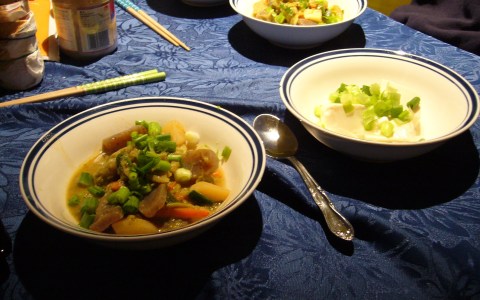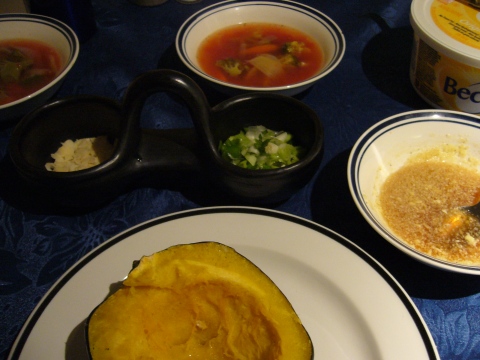
Konnyaku stir fry
I was introduced to a new, erm, substance in this stir fry. I had read about konnyaku on the Just Hungry blog, and I asked Yusuke if we could try it. Konnyaku is a gelatin-ish food made from the konjac (a.k.a. konnyaku) plant. The package that we bought calls it “yam cake,” but apparently it has no relation to yams or potatoes of any sort. Konnyaku is described as a miracle health food, since it is very filling, has almost no calories, and has tons of fibre. The texture is the main appeal for me, and it’s impossible to describe to someone who hasn’t eaten it. It’s not as chewy as a jelly bean, but it’s much firmer than silken tofu, and it’s not dry and crumbly like firm tofu.
Like tofu, it soaks up and compliments any flavours that are combined with it. In addition to the konnyaku, the stir fry includes potatoes, carrots, and green onions. Yusuke used his standard stir fry ingredients, namely ginger, garlic, and soy sauce (and maybe salt, mirin, sugar?).
Our side dish was yudofu topped with green onions, ginger, soy sauce, and bonito flakes.
Apparently one of the concerns over konjac as a jelly snack is that it can be choking hazard and is actually banned in North America. I also read a caution that swallowing it without chewing it properly has unpleasant consequences for some people.
A note on sources: I read the wikipedia article on konjac as well as the informative konnyaku posts on Just Hungry. Of course the Internets provide many other additions to konnyaku wisdom. For example, I particularly enjoyed this site’s pronouncement: “Konnyaku is one of the most effective items for defending yourself from fatness.” And another: “Konnyaku surely helps your physical and mental health.” Sounds good to me!














